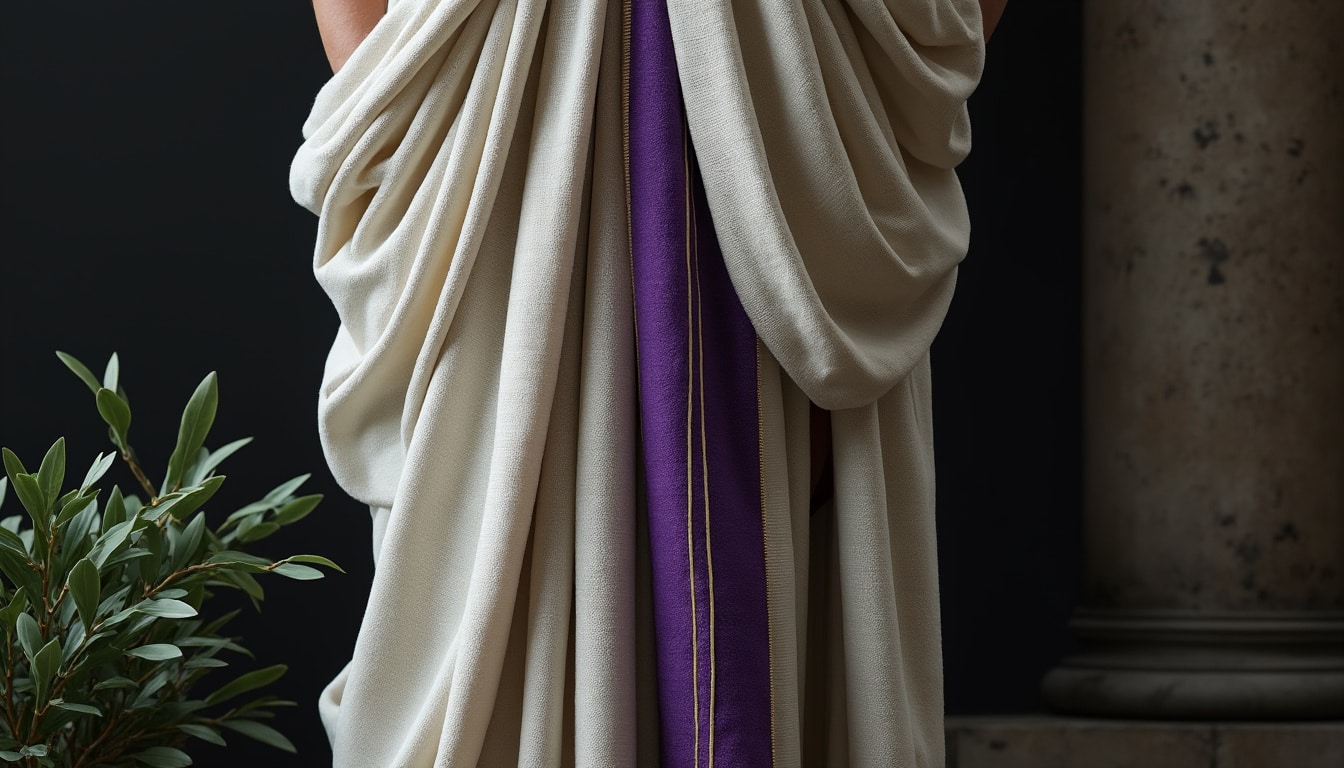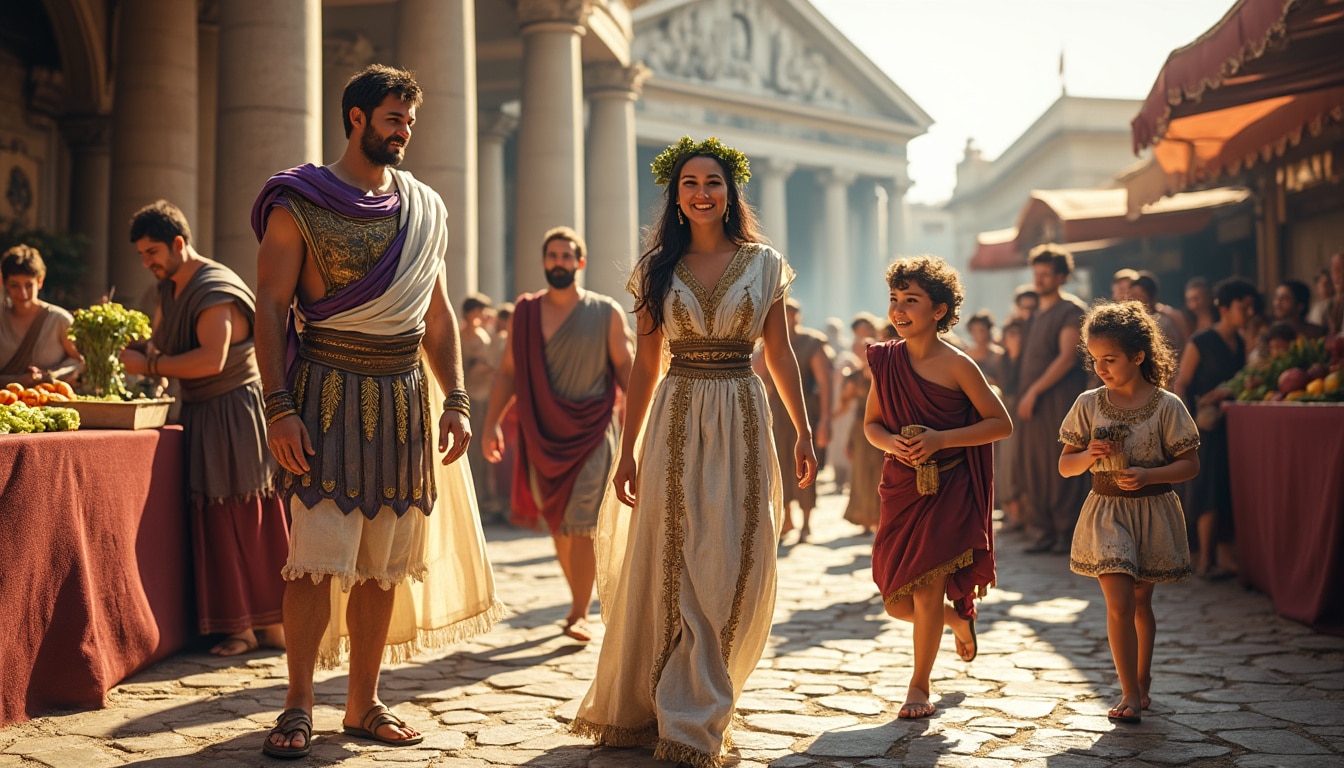When we walk the cobblestone streets of Rome or gaze at its architectural marvels, it’s fascinating to think about the long-standing clothing traditions that have woven the fabric of Roman culture. Clothing customs in Rome have always played a significant role in depicting social stratification, religious observances, and personal identity. They offer us a window into the past and hold secrets that go beyond mere fashion. As we delve into the sartorial legacy of Rome, let’s discover how these customs reflect an intricate tapestry of history, culture, and status.
The Toga: A Symbol of Roman Identity and Citizenship
The toga is perhaps the most iconic garment associated with ancient Rome. Known for its voluminous fabric and complex draping, the toga was a garment imbued with meaning and status. Contrary to popular belief, the toga wasn’t everyday wear for most Romans. It was a ceremonial garment symbolizing Roman citizenship, and its wearers could often be seen attending formal events or participating in religious ceremonies. 🏛️
Togas were made from wool and varied in type according to the wearer’s status or occasion. The Toga Pura was plain and typically worn by average citizens. In contrast, the Toga Praetexta, adorned with a purple border, was reserved for magistrates and young boys of noble birth participating in rites of passage. For mourning periods, citizens wore the Toga Pulla, a dark version of the garment.
The most sumptuous toga, known as the Toga Picta, was a purple garment embroidered with gold and worn by victorious generals or emperors. Julius Caesar himself is famed for wearing the Toga Picta during his triumphal processions.
| Toga Type | Description | Wearers |
|---|---|---|
| Toga Pura | Plain white toga | Common citizens |
| Toga Praetexta | White toga with purple border | Magistrates, freeborn boys |
| Toga Pulla | Dark-colored toga worn in mourning | All citizens during mourning periods |
| Toga Candida | Artificially whitened toga | Candidates for political office |
| Toga Picta | Purple toga embroidered with gold | Victorious generals, emperors |
The toga’s impractical design wasn’t just an aesthetic choice but also a distinct display of leisure. Wearing it required the assistance of slaves, a sign of wealth and status. Moreover, the garment’s cumbersome nature often restricted free movement, reinforcing the distinction between manual laborers and the upper echelons of society who could afford to be at leisure.
Explore how Roman culture and lifestyle intertwined with clothing, solidifying the toga not only as a garment but as a statement of citizenship and Roman identity.

The Practicality of Tunics in Everyday Roman Life
While the toga was emblematic of prestige, the tunic played a more practical role in daily Roman life. Worn by men and women alike, the tunic was a simple yet versatile garment serving as the backbone of Roman clothing. It was typically crafted from two rectangles of cloth sewn together and belted at the waist, allowing for easy movement—a stark contrast to the cumbersome toga.
Men typically wore shorter tunics reaching just above the knee, while women donned longer versions extending to their ankles. This distinction also mirrored societal expectations, with longer garments often symbolizing modesty and decorum.
The richness of a tunic’s fabric and color could convey the wearer’s standing in society. While poorer Romans wore undecorated wool tunics, wealthier citizens flaunted theirs in fine linen or even silk, sometimes dyed in vibrant hues. Silk, a luxury import at the time, became more accessible through trade routes connecting Rome with distant lands. 🛍️
Judging by the mosaics and frescoes discovered at various archaeological sites, Roman fashion exhibited a diverse color palette. The coveted Tyrian purple, a hue obtained from murex snails, was particularly prized and often reserved for the elite. By the 4th century CE, regulations restricted its use, as seen in historical edicts that aimed to maintain the color’s exclusivity among the imperial class.
Rome’s ever-expanding boundaries resulted in regional variations within its fashion tapestry. In colder regions like Britannia, tunics adapted to the icy climate, featuring full sleeves and additional layering. As documented in archives like the Vindolanda tablets, Roman soldiers stationed in these locales requested warm tunics, socks, and other garments suitable for inclement weather.
By browsing through contemporary resources on Rome’s seasonal weather, we see echoes of these clothing adaptations. Understanding the tunic’s variability offers insight into how practical attire developed to foster comfort and style amid Rome’s evolving empire.
Cultural Symbolism in Roman Accessories and Adornment
Beyond garments, accessories played a crucial role in ancient Roman fashion, elevating an outfit from mere attire to a statement of individuality and status. Both men and women adorned themselves with jewelry crafted from gold, silver, and precious stones, thus indicating their wealth and social position.
Rings were worn in abundance, and brooches known as fibulae fastened garments, often showcasing intricate designs. The practice of personal adornment didn’t just stop at jewelry. Romans paid meticulous attention to hairstyles, with women styling their hair into elaborate plaits and curls.
- 📿 Jewelry: Rings, fibulae, necklaces, and bracelets adorned with opulent designs
- 💇♀️ Hairstyles: Complex arrangements signaling status and fashion trends
- 💄 Cosmetics: Makeup that included rouge, eyeliner, and face powder to enhance appearance
Cosmetics were widely used among the Roman elite, with options available for both men and women. Makeup routines often included face powders, rouge, and even eyeshadow made from naturally sourced pigments. For the upper-class woman, beauty rituals weren’t just about personal vanity but were considered essential to maintaining one’s place in social circles.
Wigs, often made from the hair of enslaved individuals, and hairpieces allowed wearers to sport various colors and styles. Blonde hair, in particular, was highly sought after due to its rare and exotic appearance. This fascination with appearance paralleled modern fashion houses like Valentino and Versace, where stylistic flexibility remains a valued asset.
Much like today’s top brands such as Gucci and Prada, Roman fashion was not immune to the influences of global trade. Luxury goods filtered into Roman markets, enriching the cultural tapestry of the empire. Fashion, then, as now, was an evolving narrative woven with threads of artistry, identity, and societal norms.
For a deeper dive into Roman society and its age-old customs, check out these intriguing insights that connect past and present Roman life.
Regional Influences and the Legacy of Roman Fashion
Roman fashion was not static; it absorbed and reflected the myriad influences encountered as the empire expanded its reach. The incorporation of styles from conquered lands enriched Roman clothing customs, adding new dimensions and complexities.
During its height, the Roman Empire spanned from Spain to the Black Sea, and from Britain to Egypt. This vast expanse enabled a vibrant exchange of textiles, dyes, and fashion concepts. Through trade and cultural assimilation, Roman attire became a colorful mosaic, borrowing elements from each of these regions.
For example, in warmer Eastern provinces, lighter, billowing fabrics were more prevalent. Meanwhile, in cooler climates, heavier garments with multiple layers became a necessity. The diversity bestowed by regional dressing customs speaks volumes about Rome’s ability to adapt and integrate differing traditions.
Notable among regional influences was the incorporation of Eastern textiles and their sophisticated dyeing techniques. These contributions elevated Roman fashion from simple utility to works of art, mirroring today’s luxurious offerings from designers like Dolce & Gabbana and Miu Miu who infuse modern collections with historical motifs.
| Region | Influence on Roman Fashion | Example |
|---|---|---|
| Greece | Draping styles, intricate clothing | Roman adaptation of the Greek himation |
| Egypt | Fine linens, distinctive patterns | Adoption of Egyptian shawls in warmer regions |
| Britain | Warm, woolen layers | Tunics adapted for harsh winters |
| Persia | Exotic dyes and luxurious textiles | Incorporation of rich purples and silks |
The ingenuity of Roman fashion design lies not only in adaptation but in anticipation. Even as the empire crumbled, its sartorial legacy lived on, influencing civilizations that followed. Much like today’s brands—Armani and Bulgari—Roman attire possessed a timeless quality, ensuring its enduring appeal.
To learn more about Rome’s absorbing history and how its garments tell tales of power and privilege, explore insights into the past through Rome’s local culture and life.
Contemporary Echoes of Roman Fashion Trends
The legacy of Roman clothing customs resonates even today, visible in modern fashion influences that echo ancient trends. Designers and fashion houses continue to draw inspiration from Roman aesthetics, infusing garments with a timeless elegance rooted in historical grandeur.
The toga’s distinctive draping, for instance, can be seen in high-fashion runway shows, where designers manipulate fabric into sophisticated gowns and garments. This style mirrors the ceremonial elegance of Roman senators clad in their resplendent togas.
Likewise, modern fashion brands like Fendi and Ovfis have embraced the Roman penchant for material opulence and detail. Their collections pay homage to the luxurious fabrics and intricate designs that once graced Roman forums and banquets.
- 👗 Fabric Draping: Seen in contemporary gowns reminiscent of the Roman toga
- 💎 Opulent Materials: Use of silk and velvet echoing Roman luxury
- 💫 Richly Embroidered Details: Inspired by Roman ceremonial garments
Today’s emphasis on sustainable fashion also finds a parallel in the resourcefulness of ancient Romans, who often repurposed fabrics and garments. Today’s designers, aware of environmental impacts, have implemented eco-friendly practices, much like the resourcefulness seen in ancient Roman society.
In fact, the cyclical nature of fashion ensures that ancient inspirations remain perpetually relevant. The adaptability and timelessness of Roman fashion remind us that the past leaves an indelible mark on present and future creativity.
By examining how Rome’s sartorial past continues to inspire today’s fashion landscape, you can discover more about what to wear when visiting Rome. With a rich history and a vibrant present, the Eternal City’s fashion legacy endures through the ages.
Frequently Asked Questions about Clothing Customs in Rome
- What was the significance of the toga in ancient Rome? The toga was a symbol of Roman citizenship and status, worn during formal occasions and ceremonies.
- How did Roman tunics differ between genders? Men’s tunics were typically knee-length, while women’s extended to the ankles, signifying modesty and social expectations.
- Were there restrictions on certain fabrics or dyes in Rome? Yes, certain colors like Tyrian purple were restricted for imperial use, reflecting social stratification and exclusivity.
- What regional influences shaped Roman fashion? Regions like Greece, Persia, and Egypt significantly influenced Roman fashion with their textiles, styles, and dyeing techniques.
- How does Roman fashion influence modern styles? Elements like toga draping and luxurious materials continue to inspire contemporary fashion designers and trends.

